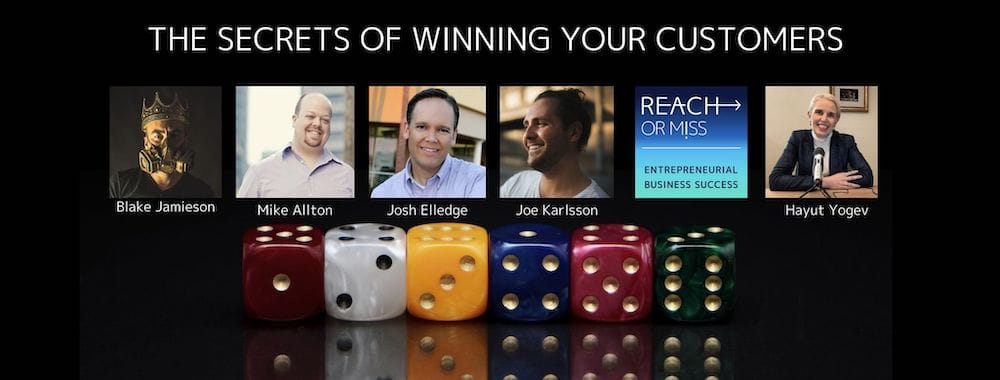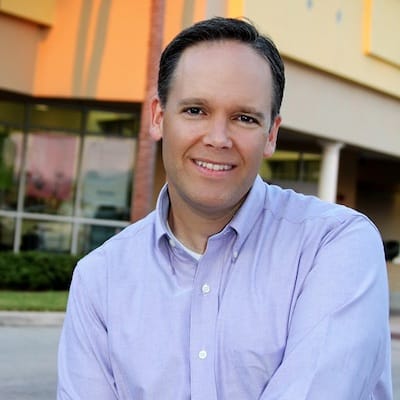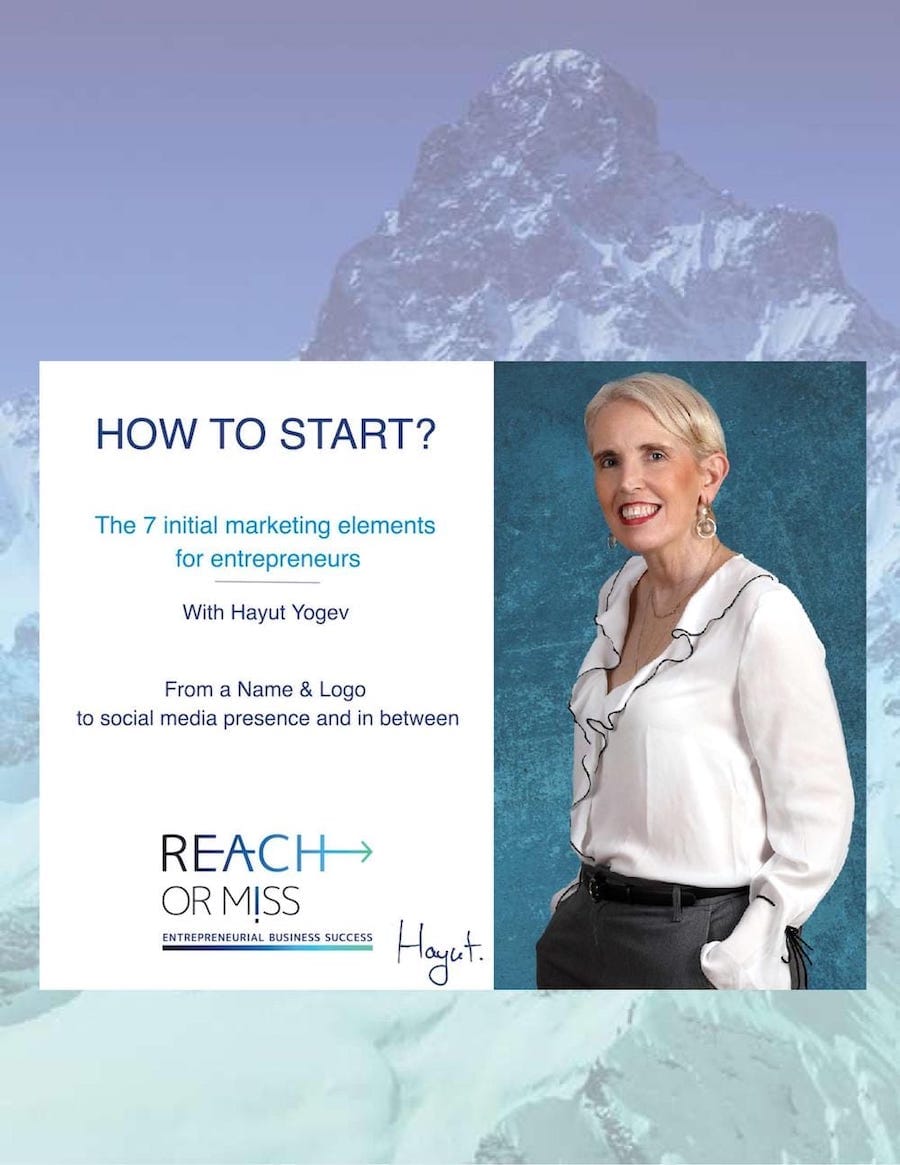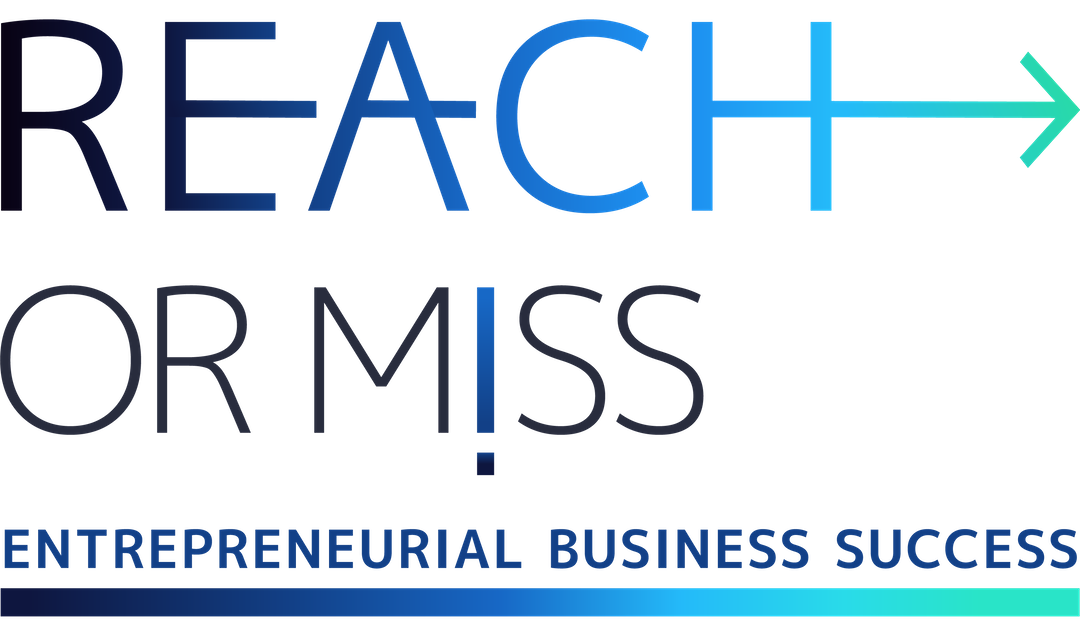Ep. 183 – The secret of winning your customers: The What, The Who, And the How.

Getting customers is what entrepreneurs say they struggle with most.
When we talk about entrepreneurship success, we still talk about very low success rates (The last formal numbers are still between 5%-10%. Of course, it depends on how success is defined).
The first reason (42%) entrepreneurs say what they fail for is “No market need”. There are usually two reasons for not finding the market need:
Either you didn’t focus on the right customers, Or your product definition wasn’t correct.
The What
A product or service definition contains 3-5 words;
your answer to the question, “What do you offer?” Based on the answer to the question “What problem do you solve”
Why is defining your product or service critical?
- ⌘ That’s how customers will find you
- ⌘ It differentiates you from your competitors
- ⌘ It attracts clients
- ⌘ It’s the basis for leading your market category
The one rule of defining your product: In defining your product, you should focus on your customers’ point of view:
You need to learn what your customers are looking for; How customers, people who are seeking solutions, and providers talk about the problem and solutions within your space
We look for what they need or want: What words do they use to look for the solution?
Remember, it’s always about them! The customer always looks to find ‘WIIFM’ – What’s In It For Me?!
There is one story I like most as an example for the “what” part, finding what solution and product (or service) you should provide.
The story of Mike Allton who provided one product and found out his customers want something else…
 Mike Allton – The award-winning social media blogger and author turned his successful website business into a social media blog and guidance source. Mike Allton is a Content Marketing Practitioner, award-winning Blogger and Author in St. Louis, and the Chief Marketing Officer at SiteSell. He has been working with websites and the Internet since the early ’90’s, and is active on all of the major social networks.
Mike Allton – The award-winning social media blogger and author turned his successful website business into a social media blog and guidance source. Mike Allton is a Content Marketing Practitioner, award-winning Blogger and Author in St. Louis, and the Chief Marketing Officer at SiteSell. He has been working with websites and the Internet since the early ’90’s, and is active on all of the major social networks.
Mike teaches a holistic approach to content marketing that leverages blog content, social media and SEO to drive traffic, generate leads, and convert those leads into sales.
Mike’s story
- I started the Social Media Hat back in 2012. At that time, I had been building websites, and as part of that website business, I was blogging about social media marketing in order to give my prospects and customers helpful information. It didn’t attract people who needed websites, it attracted people that already had website and wanted to learn about their social media opportunity.
- So, as a result, I wasn’t growing my online business, but I discovered that I like to write and I like to teach people how to use social media blogging.
- I realized that the content doesn’t help to sell websites, however I decided to create a site about social media blogging and that what I did.
- I’ve used my site as a testing ground for anything related to online marketing. I execute the test and write about it and I found out my audience really appreciates those kinds of insights.
- And in the meantime, I was experiencing making money through the website and I tested that as well. Affiliate relationships, Google AdWords, Display ads, and many other monetization techniques. The most successful way to make money is to have a product that can you sell a lot of, so it can scale.
What is your one key success factor?
- One thing that comes to mind: to have specific online relationships with people that can help you and show you the way to achieve your goals.
The Who
Most entrepreneurs have a very clear picture in mind as to who their customers are.
Unfortunately, most of the time, they are wrong.
If you don’t know who your customers are, you won’t reach them.
Let’s learn one of the best-kept secrets to business success
The secret to finding more paying customers is not to convince as many people as possible to buy your product or service.
It’s to find those people who need your product or service right now and who will be the first to buy it.
I love the story of Black Jamieson. First because Black is a unique entrepreneur, and this is a beautiful story.
And second because it shows exactly how crucial finding the right customers is.
 Blake Jamieson studied economics and today is a Portrait Artist for Professional Athletes Blake Jamieson is a pop portrait artist in Manhattan, NY. He paints pop art portraits for professional athletes and celebrities, including Howie Mandel, Drew Brees, Joe Montana, Gary Vaynerchuk, and over 250 other professional athletes in the NFL, NBA, NHL, MLS, and PLL.
Blake Jamieson studied economics and today is a Portrait Artist for Professional Athletes Blake Jamieson is a pop portrait artist in Manhattan, NY. He paints pop art portraits for professional athletes and celebrities, including Howie Mandel, Drew Brees, Joe Montana, Gary Vaynerchuk, and over 250 other professional athletes in the NFL, NBA, NHL, MLS, and PLL.
Blake’s path to becoming a full-time artist was far from traditional. Despite his passion for art at a young age, Blake decided to forgo art school for a more “practical” degree, studying Economics at UC Davis. After graduating, Blake began his career in digital marketing at Zynga. He worked in digital marketing for nearly a decade, working for small tech startups to publicly traded companies.
On his 30th birthday, Blake decided it was time to stop building someone else’s dream, and start to following his own passions. He began painting full-time nearly five years ago, and has carved out a niche that allows him to paint every day.
What Blake is most passionate about today
- I’m a portrait artist located in NYC. I’ve had an interesting rollercoaster of a journey up until this point, but what I do now is paint portraits of professional athletes.
- Primarily, I have worked in the NFL, although I do work with other athletes who play soccer, lacrosse, hockey, and more.
- I created this niche for myself where an athlete, or the spouse or girlfriend of an athlete, is looking for a painting that will capture special sports moments for them. I’m often the person they turn to and I’m very fortunate to work with awesome people and get to paint every single day.

Blake’s story
- I grew up in a very creative household. I was always encouraged to paint, or draw, or do photography – all the things I do today. However, I convinced myself, from a young age, that art was about being a starving artist and that it was not a career path.
- Instead of doing what my parents encouraged me to do, which was to study art in college, I decided to study economics and tech. I thought this was the safe path at the time, and I aimed to have a career in marketing.
- When I graduated from college, social marketing was just starting to become an actual, respected career. I was able to get into very grounded levels for some reputable companies and work my way through several different companies. Then I spun off and started working for myself as a freelancer.
- Ultimately, on my 30th birthday, I decided that I was tired of working for someone else’s dream. I wanted to follow my own dreams and I realized that maybe my parents had been right all along…
- I’m very grateful. Due to my background in marketing – especially digital marketing – and my experience in marketing a wide range of products, I understand how social selling works and how it is really a relationship-building business. I built up a moderate following of friends, family, colleagues, and people I met along the way.
- When I first decided to start painting, I knew that I had to specialize and come out with a specific niche. I decided that I would paint a specific painting for a specific subset of people.
- Because of my networking at the time, I decided to paint for offices, especially for tech companies. I met with the people on my contact list and told them that I was an artist and that I painted office art for tech companies.
- At first, I painted many paintings of Steve Jobs, Gary Vaynerchuk, and different iconic tech founders. Those tech companies aspired to be like them and wanted to put a picture of Steve Jobs, or motivational quotes, in their offices.
- I did that for two years and it was going well. I had my niece called out and I was gaining a reputation as one of the leaders in the space of Portrait Painting for Professional Athletes.
- There was a really lucky coincidence that when I delivered art in Las Vegas, I met a guy who played in the NFL and who was now a manager of existing players. He really loved my art and asked me to paint a few of his clients as a gift that they would post about and promote to their followers. It might create new opportunities.
- I did some paintings of a few of his NFL players. In the process, I learned that NFL players are very competitive. If one guy has a painting, the other player wants a bigger painting. They also have the income to pay for that, as well as a lot of followers.
- I pivoted my business three years ago. Today, I paint more professional athletes than any other painter in my space
 Joe Karlsson chose his customers first, and only then he developed his service. ”It took me years to get there, but right now I have my dream job!”
Joe Karlsson chose his customers first, and only then he developed his service. ”It took me years to get there, but right now I have my dream job!”
Joe Karlsson is a software engineer turned Developer Advocate at MongoDB. He comes from the frozen tundra of Minneapolis, Minnesota (and yes, it does get really cold here, and no, not everyone here has the accent from the movie, Fargo).
Joe has been primarily a Node and JavaScript engineer. He has been writing, teaching, and talking about code his entire career. Sharing what he knows and continuing to learn about programming is truly the thing he loves doing the most.
Most passionate about
- I’m most passionate about Developers Advocate. I work for a database software tech company called MongoDB. As part of my job, I get to hang out with developers all the time. I make cool tools for them, or documentation, I speak at tech conferences and I make videos at Twitch stream.
- Whatever developers need, I make that for them.
- I still consider myself a software engineer, but I’m just better at engaging with developers.
Joe’s career and story
- I first started learning how to program. I started learning it out of fear of not making money when I was a professional.
- I actually was an art history minor, and then I switched over to computer science for fear of being poor.
- I went to school during one of the last financial collapses. Then I worked as an engineer and programmer for years. I hated it. I was so bad at it.
- I was ready to quit programming, and I moved to Hawaii to become a surf bum. Then I met some hacker punks down there, who were making fun stuff, making art. It got me very excited about making stuff just for fun.
- That changed the way I looked at programming. I’ve been trying to share the joy that I felt ever since.
Joe’s one key success factor
- I feel like my one success factor is resiliency or net durability while allowing my target audience (and my company) to keep going over a long period of time, remaining focused on a goal and continuing to attack it.
- Developer relations is tricky because I’m trying to influence a massive community of developers. The results are not immediate.
- I think my key success factor is resilience, and the best entrepreneurs are the ones who can remain focused on a singular goal over a long period of time. And I’m not saying you don’t quit if it doesn’t work.
The How
This is probably the most important part that often has been neglected.
Zig Ziglar, a very famous American author, salesman, and motivational speaker said “You will get all you want in life if you help enough other people get what they want,”
Today, most known marketing leaders talk about being human – Mark Schafer wrote in his last book Marketing Rebellion that “The most human company wins”.
David Meerman Scott wrote with Reiko Scott the book ‘Fanocracy’ – Turning fans into customers and customers into fans’.
I think the story that represents more than any other story the shift in your mindset that will allow you to get many customers is the success story of Josh Elledge.
 Josh Elledge hated to sell until one day he found the win-win formula of selling. Josh Elledge is the Founder & CEO of UpendPR and is about to change an entire industry with the mission to help entrepreneurs attract the perfect audiences through PR.
Josh Elledge hated to sell until one day he found the win-win formula of selling. Josh Elledge is the Founder & CEO of UpendPR and is about to change an entire industry with the mission to help entrepreneurs attract the perfect audiences through PR.
Josh is Chief Executive Angel at SavingsAngel.com and helps consumers get discounts and upgrades on everything through his syndicated newspaper column with 1.1 million readers and on TV in 75 cities. He’s been in the media more than 1500 times.
Through his new model of PR Josh now turns digital entrepreneurs into media celebrities at upendPR.com
Josh best advice about approaching the customer
- Most entrepreneurial business owners struggling because they keep trying sell so hard, and it may cover the bills; however, I believe that in 2017 and beyond, the only way to really succeed is to invest in relationships and spend any minute in serving and giving and create value for your customers through building your sought leadership. Then the customers will come to you.
Biggest failure with customers
- When I started as an owner of a small-town newspaper, I was so uncomfortable to sell; I was so scared that I failed miserably. And after that, I did sales and marketing for a law firm network for the next five years and had to sell every day for a commission-based salary. I was very miserable, and then, one day, I suddenly realized that it’s not about convincing people to buy; it’s about listening to people’s needs and finding how I can help them. In the minute, I understood that, I started to enjoy my connection with my clients and started to succeed dramatically. I found the win-win formula.
Biggest success due to the right customer approach
- I was featured in the local newspaper with Savings Angel, but one day I got a phone call from a reporter. It was from the Grand Rapids, Michigan, that I wanted to interview me about savings angel, and that was the first day we earn 800$ in one day, “my first good money day” from that day forward, my wife and I never had to worry about money again.
- If you are an entrepreneur listening to this conversation and you are not yet there, trust me, you will get there.
We covered today the first, main part of getting more customers. This is the foundation.
Soon I will share with you the practical ways to get more customers.
However, If you won’t make the shift in mindset that my guests talked about today, I’m not sure you will succeed in implementing the practical ways to get more customers.
I want you to feel like Josh Elledge, that you found the win-win formula of selling.
I’ll meet you here next week.
In the meantime, I hope you and your beloved ones stay healthy and safe.
Always yours,
Hayut.
Join our Facebook Groups
More resources for Entrepreneurs
- Don’t Miss – Customer Focus Strategy & Execution: Market Analysis for Fundraising
- Hayut Yogev’s Latest post: Is the magic that helped entrepreneurs like Jeff Bullas (570K Twitter followers) or Douglas Burdett become leading successful influencers happening again?
- Former interview: Joe Karlsson ”It took me years to get there, but right now I have my dream job!” Can you say the same??
 Want to learn how to start your Entrepreneurship?
Want to learn how to start your Entrepreneurship?
Download for Free
HOW TO START ?
The 7 initial marketing essentials
for entrepreneurs
Want to learn how to choose the best Name and Logo? Not sure which customers to focus on right now and where they are? Want to build your website, or trying to figure out how and what content to share on social media?
